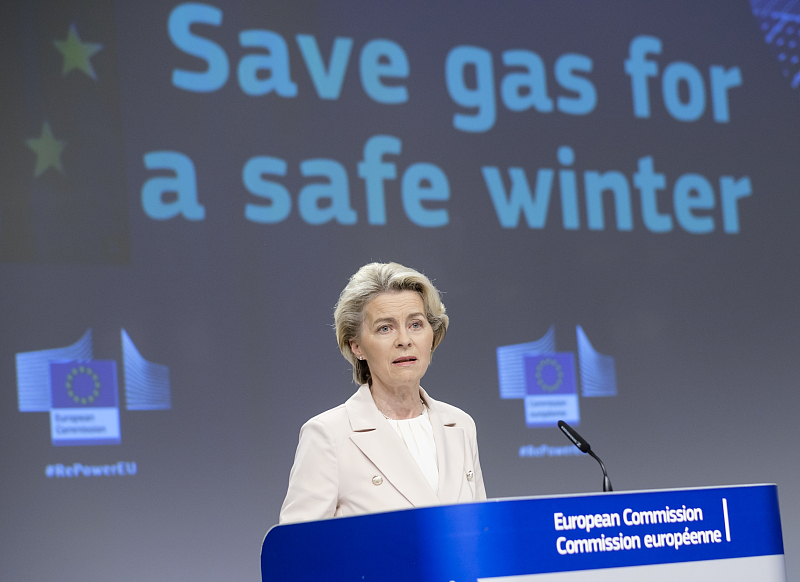
Cooling towers release water vapor at the Nogent nuclear power plant, operated by Electricite de France SA (EDF), in Nogent-sur-Seine, France, December 21, 2021. /CFP
Cooling towers release water vapor at the Nogent nuclear power plant, operated by Electricite de France SA (EDF), in Nogent-sur-Seine, France, December 21, 2021. /CFP
Editor's note: Freddie Reidy is a freelance writer based in London. He studied history and history of art at the University of Kent, Canterbury, specializing in Russian history and international politics. The article reflects the author's opinions, and not necessarily the views of CGTN.
For many Europeans, summer is a celebration of warmth and heat, affording the opportunity to soak up some much-needed vitamin D but be careful what you wish for.
As the United Kingdom, France and Italy battle a succession of record-breaking heatwaves and forest fires, Germany is witnessing a confluence of environmental and geopolitical crises. Water levels in the Rhine have dropped to such an extent that it is no longer navigable by large trading vessels.
The waterway has long been a vital conduit for German, Swiss and Dutch economies, especially in the transportation of gas, oil and coal. While the country has sought to pursue a more environmentally energy policy, progress has been slow. Germany's abandonment of nuclear power in the aftermath of the Fukushima Daiichi nuclear disaster after the Tohoku earthquake in Japan placed further pressures on the country.
The fundamental truth, however, is while the Ukraine crisis exposed a massive overreliance by many nations on imports of hydrocarbons, water is of course the most fundamental and perhaps neglected commodity.
In order to achieve the commitments of the 2021 United Nations Climate Conference (COP26), a massive energy transition is required. Energy generated by nuclear power and hydropower facilities is a big component of such necessary ambitions, yet these sources of power are under threat as a direct result of the recent drought.
According to the research firm Rystad Energy, usage of nuclear power usage dropped by 12 percent and hydro power has fallen by an alarming 20 percent between January and July year on year.
In France, half of the nation's reactors are offline owing to maintenance issues and exceptionally low river levels, river water being used as the primary coolant source. When water levels are very low and warm, power stations must cease usage of this water for cooling as the water when released back increases the river temperature further with significant ecological consequences.
However, with little alternative, the French government has had to sanction the release of warm water into French rivers at several sites. The ASN watchdog stated that "The government considers that it is a public necessity to... maintain the production of these five power stations until September 11th despite the exceptional weather conditions."
With drought hampering the transportation of hydrocarbons in addition to a decline in hydroelectric power generation due to water shortages, many nations who traditionally export electricity such as Norway, are now predicting that this practice may have to be curtailed. Water levels in the south of the country are at their lowest in 26 years according to the Norweigan Water Resources and Energy Directorate.

President of the European Commission Ursula von der Leyen told media about proposing gas demand reduction plan to prepare EU for supply cuts in the Berlaymont, the EU Commission headquarter in Brussels, Belgium, July 20, 2022. /CFP
President of the European Commission Ursula von der Leyen told media about proposing gas demand reduction plan to prepare EU for supply cuts in the Berlaymont, the EU Commission headquarter in Brussels, Belgium, July 20, 2022. /CFP
While we should be weary of the distinction of weather and climate, the number of record-breaking weather phenomena in the past few years indicates a long-term shift. At the advent of this change, we are already seeing the tools we need to mitigate climate change come under severe strain. Even solar farms are suffering from the impact of adverse heat without dramatically dropping above 25 degree Celsius.
Greater efforts must therefore be taken to alleviate the strain of water and energy shortages whether this is at a domestic, national or international level. Upgrades to infrastructure, a transition to more modern and efficient domestic appliances and heat sources can all contribute to vital conservation.
Tree planting initiatives must also gather pace to aid localized cooling and water retention. In Singapore, the nation faces a dangerous escalation as temperatures rise followed by increased energy demands for air conditioning and a further reliance on water imports. The government has therefore committed to the planting of one million trees by 2030 to try and ease the situation a policy eminently simple to replicate.
The crisis in Ukraine and the subsequent economic aftershocks have highlighted the fragility of global energy supplies as well as a severe impact on global food supplies. Failed crops as a consequence of drought could replicate the impact to food supplies as a consequence of the war and similarly heat strain on our systems of energy generation.
The warning signs are there and growing ever louder. Even to climate change sceptics, the status quo is no longer tolerable. Observing the energy situation in France and the UK where each nation periodically imports power from the other, Kathryn Porter of Watt-Logic ominously remarked that "If both French and UK systems are in stress at the same time, then nobody really knows what will happen." With rising temperatures and common drought, this is a situation likely to be replicated across the globe.
(If you want to contribute and have specific expertise, please contact us at opinions@cgtn.com. Follow @thouse_opinions on Twitter to discover the latest commentaries in the CGTN Opinion Section.)

